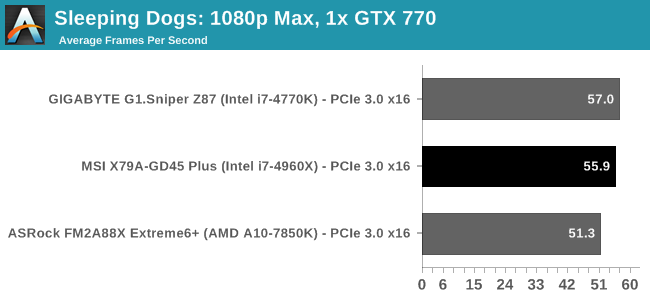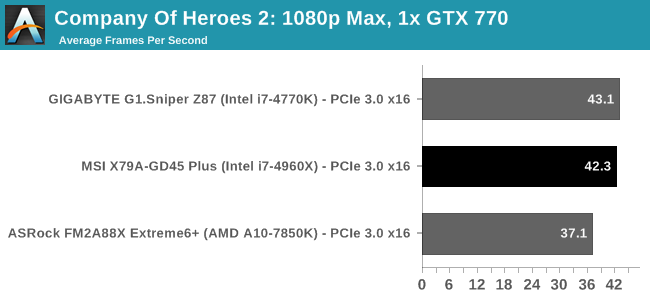MSI X79A-GD45 Plus Review: Building Up
by Ian Cutress on February 14, 2014 10:00 AM EST- Posted in
- Motherboards
- Intel
- MSI
- X79
Gaming Benchmarks
Sleeping Dogs
Sleeping Dogs is a benchmarking wet dream – a highly complex benchmark that can bring the toughest setup and high resolutions down into single figures. Having an extreme SSAO setting can do that, but at the right settings Sleeping Dogs is highly playable and enjoyable. We run the basic benchmark program laid out in the Adrenaline benchmark tool, and the Xtreme (1920x1080, Maximum) performance setting, noting down the average frame rates and the minimum frame rates.

| Sleeping Dogs, 1080p Max | ||
| NVIDIA | AMD | |
| Average Frame Rates |
|
|
| Minimum Frame Rates |
|
|
Company of Heroes 2
The final gaming benchmark is another humdinger. Company of Heroes 2 also can bring a top end GPU to its knees, even at very basic benchmark settings. To get an average 30 FPS using a normal GPU is a challenge, let alone a minimum frame rate of 30 FPS. For this benchmark I use modified versions of Ryan’s batch files at 1920x1080 on Medium. COH2 is a little odd in that it does not scale with more GPUs, and thus only single GPU results are given.

| Company of Heroes 2, 1080p Max | ||
| NVIDIA | AMD | |
| Average Frame Rates |
|
|
| Minimum Frame Rates |
|
|
COH2 shows no scaling beyond one GPU, but there is a small advantage to having a better IPC generation of processor.












44 Comments
View All Comments
flemeister - Saturday, February 15, 2014 - link
Why? It still gets used occasionally, and it hardly takes up any room on the motherboard, unlike the old floppy and IDE headers.SirKnobsworth - Saturday, February 15, 2014 - link
Would I be correct in saying that only 3 of the secondary (2.0) PCIe lanes are being used? The PCH provides 8, but I only see one x1 slot, one NIC, and one USB 3 controller. At the very least they could have swapped the x1 slot for an x4 slot, allowing a high performance SSD to be installed.0xc000005 - Saturday, February 15, 2014 - link
This is a great board, bought one at work and it is excellent. The only letdown is that there are no drivers for windows server operating systems.Gigaplex - Sunday, February 16, 2014 - link
Considering it's using off the shelf chips that don't require special drivers, there should be no problem getting Windows Server working on it. Just don't expect them from MSIs website.Achaios - Sunday, February 16, 2014 - link
This "military class" thing is annoying.I wonder how well would this mobo fare under 5g stress, or say, after 5 days of a typical anti-guerilla mission mounted on an armoured vehicle moving through mountainous terrain/and/or cross country.
Or for instance, how well would it fare mounted on a PC onboard a Naval vessel after said vessel put its engines on "crash full astern" after making 30-35 knots on full ahead. Would this motherboard be able to withstand the excessive vibration produced by the engines of the said Naval Vessel? If not, what is the point of calling it "military class"?
AndrewJacksonZA - Monday, February 17, 2014 - link
Marketing. :-)AndrewJacksonZA - Monday, February 17, 2014 - link
I haven't played with Xeons for a while so I don't recall if Intel locks the Xeons in the factory, but assuming that this board can take it, what do you think the overclocking potential is for one of the oh-so-expensively-priced E5-2697 v2s are?mapesdhs - Tuesday, February 18, 2014 - link
XEONs are indeed locked, so the only oc'ing possible is via strapsand the limited potential of a base clock increase. In this respect,
it's easier to mess about with X58 XEONs (still locked, but oc'ing
was mostly via bclk anyway).
Ian.
mapesdhs - Monday, February 17, 2014 - link
Ian, re the SATA3 ports that are part of Intel's X79 chipset, do you know if
Intel makes a SATA3 RAID or JBOD card which uses the same circuitry
which drives their X79 SATA3 ports? Or does any other company make such
a thing based on Intel's SATA3 technology? On X79 boards which only have
a Marvell chip (terrible controller) for additional SATA3, it would be great to
be able to add a PCIe card that provided the same functionality as a full set
of proper Intel SATA3 ports. I have an ASUS P9X79 WS, specced up the wazoo:
http://valid.canardpc.com/zk69q8
but the only thing which really lets it down is the limited number of Intel SATA3
ports (ie. 2).
Ian.
Morcrist - Tuesday, February 18, 2014 - link
Is it just me, or does the author completely miss the fact that this board supports 128 GB of ram?I mean, it kinda' threw me off at first when on the first page he alternately refers to the board as a GD45 and a GD65. I thought maybe the 'GD65' only supported the 64 GB.
But no, every image in the article has GD45 on it so...
WTF?